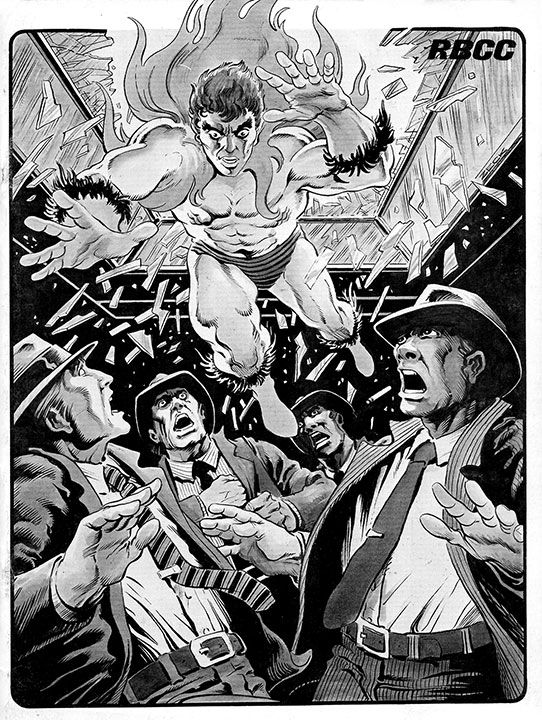
RBCC 136: 6/1977
Editor and publisher: James Van Hise
Welcome back, everyone! If you were here last month, this will instill a little Deja Vu…hopefully the good kind, since this installment features another issue of James Van Hise’s superbly consistent and high quality overhaul of fandom institution, RBCC, or the Rocket’s Blast Comic Collector. This time we cover issue 136, from the cave man days of 1977. Punk was new and Jimmy Carter had just been sworn into office. Ah, the salad days.
This issue starts with a typically stylish and dynamic cover from Mike Zeck, who in 1977, would be the artist on Marvel’s Master of Kung Fu. Additionally, as with many issues of RBCC, this issue had a theme, and it was a crazy, laughing, hairy maniac from DC called…The Creeper! Steve Ditko once again created an iconic character, though not for the company he was known for! The theme begins with an article by Mark Burbey, and a good long one it is, accompanied by some wonderful full page (and spot) illustrations, including artists Ron Wilbur, Marc Hempel, and Dennis Fujitake (the last being the back cover).
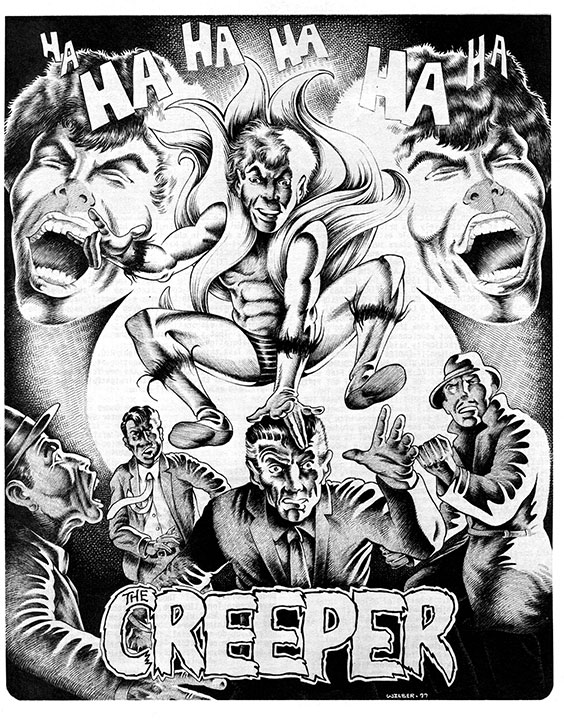
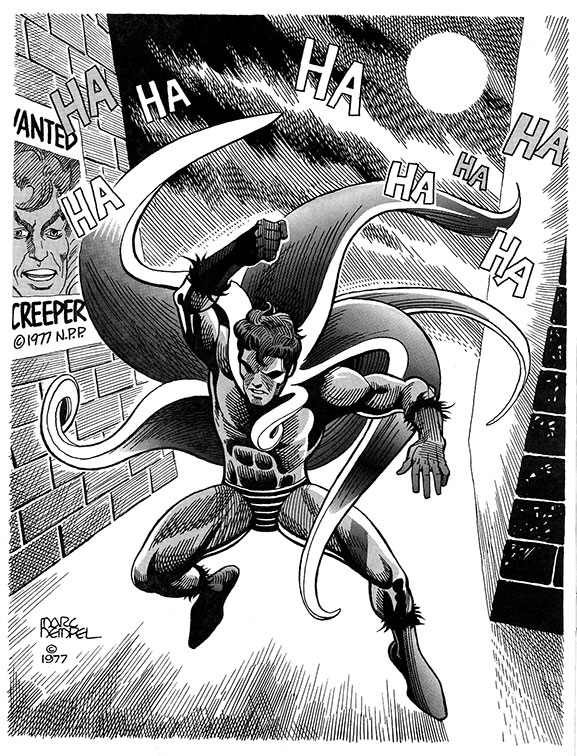

The Critique column follows, then Don Rosa’s Information Center, and lest we forget Mr. Rosa, he is covered immediately in the Artist Profile. Editor Van Hise enters the fray with Comics Commentary next, with a beautiful full page Zeck piece you can marvel at below.

R.C. Harvey covers some of the better renderers of female characters in his column, Comicopia and then Jeff Gorrell pleads the quality of Dell Comics (primarily Bugs Bunny) with Dell Comics are Good Comics. There is a nice comparison of various Bugs artists within this article.

One of my favorite fan artists comes in on the heels of the aforementioned articles, and his name is Dennis Fujitake! Not known for sequential work in fandom so much (he did, of course, go on to do comics like Dalgoda later professionally), he contributes two strips (the first being a single page entry), Evolution and A Boy and His Machine. I jumped at the opportunity to interview Dennis (he reluctantly gave in to my badgering, even though he told me that, “like my idol, Steve Ditko, I don’t give interviews”). When Dennis first started showing his work in the fanzines of that time, his Ditko influence was pretty pronounced (like his fellow Hawaiian artist, Gary Kato), but with time, I sensed some Jeff Jones creeping it. A crazy combo, you would think, but it really worked. In fact, Dennis was on the cover of my first exposure to fandom back in 1971, the eighth issue of TBG. You can see it above, but you will never get yer hands on it, it’s miiiiine! One of the very few pieces of art I own (not by me…mainly due to finances), it is very precious to me. Let’s see a few pages of his strip below and then launch into the interview.
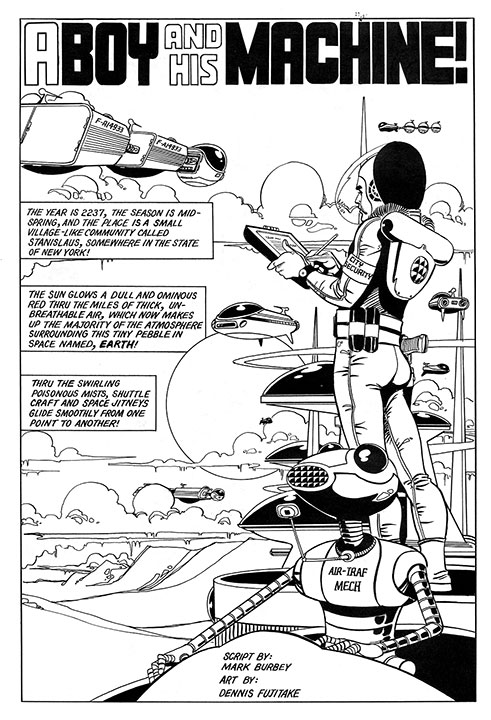
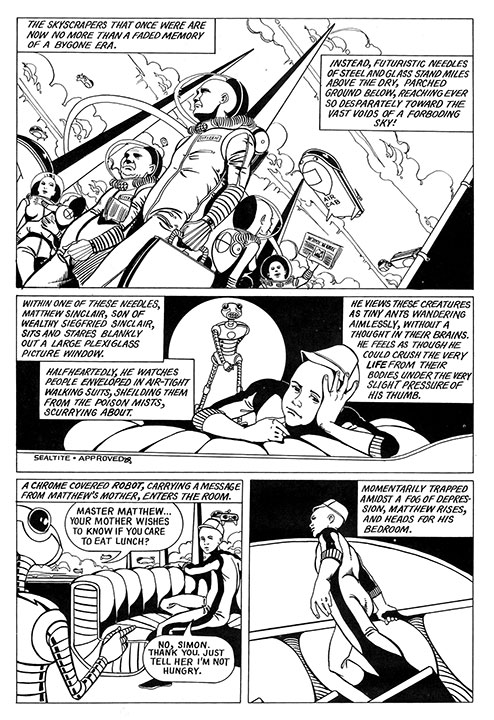
I first asked Dennis the standard “who were your influences” question, being the incisive interviewer I am not.
Although I had already been drawing pictures at home on cut open paper grocery bags, it all started in kindergarten when the teacher gave us drawing paper and those big, horsey pencils to work with. Like any kid I was drawing battleships and tanks complete with sound effects of explosions. I glanced over at another kid’s drawing and startled to see that his battleship looked way better than mine. Naturally, I had to try to replicate what he had done. Before I knew it I had a bunch of wadded up failures around me as I reached for another sheet of paper. That was when the teacher reprimanded me for using too much paper.
It all went downhill from there. In second grade I secretly drew on the backs of filler paper that had spelling quizzes on one side. To me all that glorious blank space was going to waste and I wanted to fill it up with my drawings. One day our teacher had us empty our desks out and I threw all those masterpieces in the trash. A female classmate found my work in the trash can and ratted me out to the teacher. Again, I was scolded for wasting paper?
Early on I was exposed to DC comics that a neighbor lady would give to my brothers and me. She happened to own a barbershop and had magazines and comics for her customers to read. After the comics became worn and dated she would pass them on to us. Marvel comics opened my eyes to the true potential of comic books when they entered my life when I was in middle school. I met a younger kid who had a small collection of them and he allowed me to read an early issue of Fantastic Four. After reading that one comic I was hooked. He had seen my drawings and he liked them. So he had me do a drawing and, in exchange, let me read another comic. After doing a lot of drawings for him, I realized that I could buy my own Marvels with my allowance. I would save my allowance so I could go to a sundry store across the street from where l lived to buy all the Marvel superhero books when they came out on Wednesday. From across the street I would watch the store owner rack the new comics and do a mad dash over when he was done.
Laying down on my bed I would arrange the books in order of importance. Nick Fury and the Howling Commandos was first to be read with Ditko’s Dr. Strange and Spidey being saved to be savored for last. Steve would astound me with his anatomy, composition and story telling that was truly inspiring to an adolescent nerd like me.

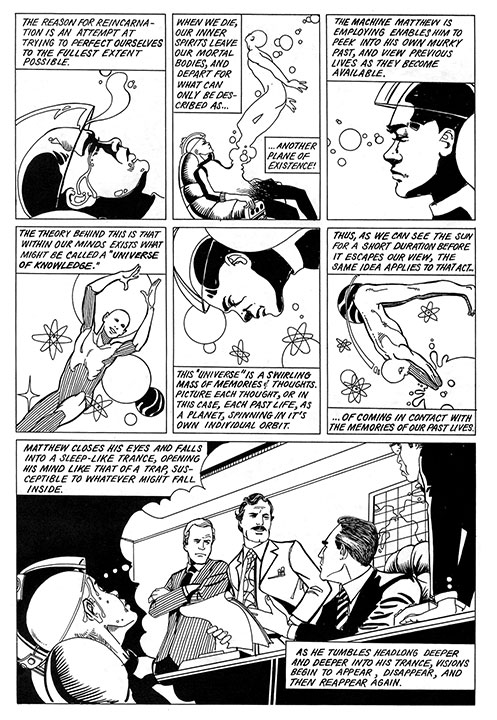
My next question involved his early involvement with fandom.
I had no idea that there was a comic book fandom until one day I was perusing Stan Lee’s Soapbox where he mentioned something called a “Fanzine!” It was Martin L. Greim’s Comic Crusader. I don’t remember if I sent away for an issue of it or if I just did a drawing and mailed it to Martin in hopes that he might publish it. He was great to work with and I never had any problems with him. It didn’t hurt that Martin seemed to have a good relationship with Steve Ditko. He was even kind enough to send a copy of a photo he had of Steve making sure to extract a promise from me to not share it with anyone. I kept my promise.
Before I knew it I was getting requests from just about every fanzine out there for comic artwork. The fan grapevine was real and my mailing address was passed around. I think that’s how I met Gary Groth and began working with him and the Comics Journal. I personally enjoyed reading the articles in the Journal and had some fun doing illustrations for some of them.
When I asked about his interaction with other members of fandom, he said, “Being isolated on an island in the middle of the Pacific Ocean doesn’t allow for much socializing with other artists and the like. Gary Kato and Stan Sakai lived here so that was pretty much it except for another guy named Keith Fukumitsu who was a great comic artist but who never pursued it as a career. You have to remember that this was before high speed internet and social media. For us it was snail mail or the more cutting edge fax machines.”
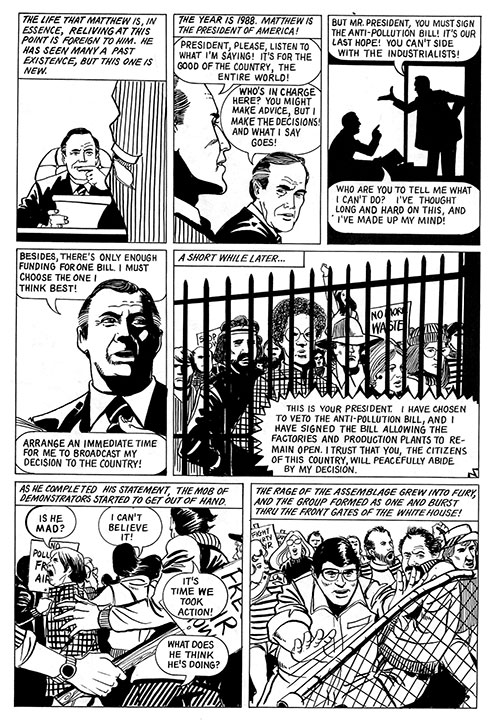
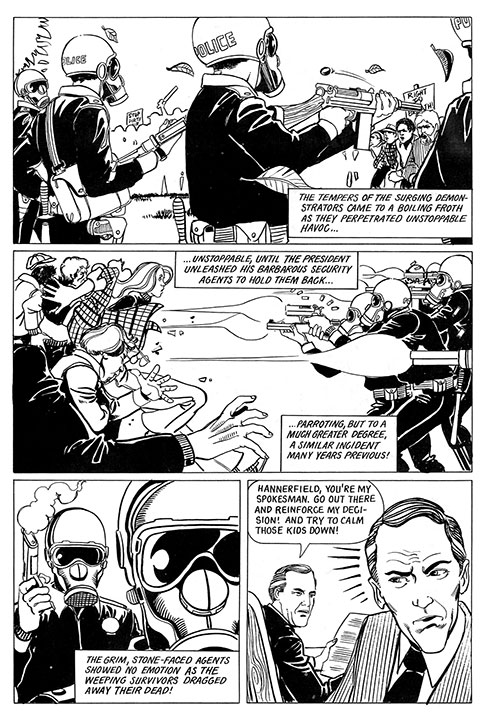
As I stated earlier, Fujitake’s primary idol and influence was Steve Ditko, but I figured he must have had some other influences.
It was Steve Ditko who impressed me with his skill as an illustrator but even more as a creative genius. In trying to replicate his work I quickly realized that I was rather inadequate in that I did not know my anatomy. That pushed me to begin finding books on the subject and trying to teach myself how to draw properly. Jeff Jones’ beautiful brush work distracted me for a while but Ditko was always my mainstay. Other geniuses like Frazetta and Moebius also had their influences in my work, not that I could ever attain their level of talent. To earn money I worked at advertising agencies so I was exposed to the illustrators who did advertising art like Bob Peak and Bernie Fuchs. Later, I found the Japanese manga artists like Katsuhiro Otomo and Masamune Shirow. Now with YouTube I find even more artists that stun me with their skills with the tablet and photoshop. I did get a tablet but my dinosaur rut is deep and I have neglected practicing with it.
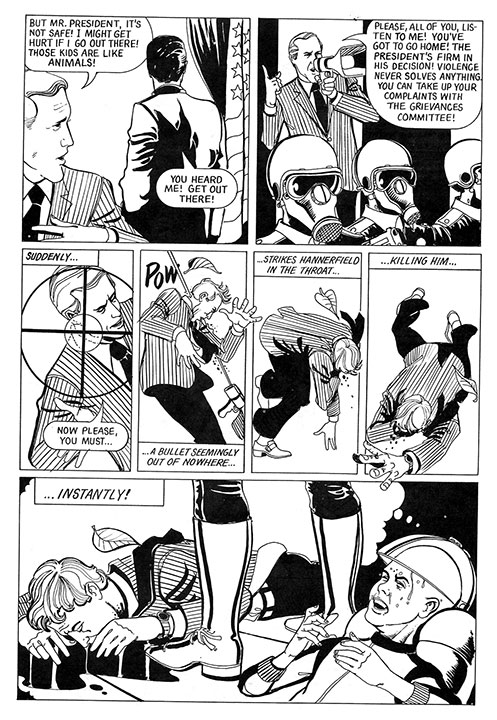
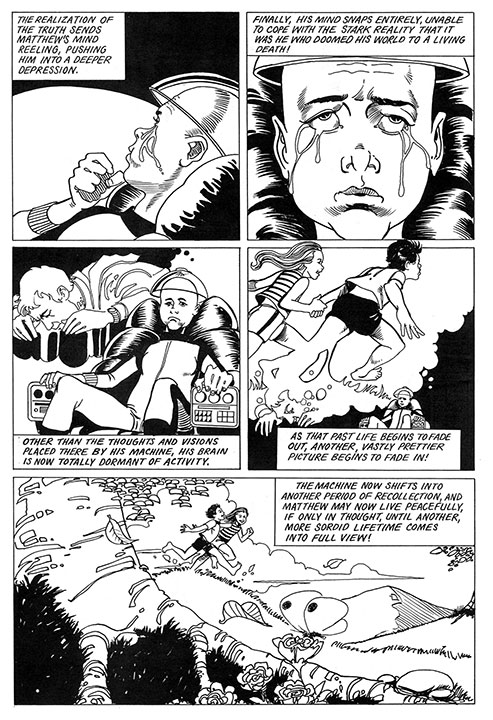
Dennis did a fair amount of work in fandom before he moved, inevitably, on to the ranks of professionals. He shared a few anecdotes about a few major players in fandom below.
Gary Groth was great to work with. He was a rebel in the business and I kind of liked that about him. I don’t remember Gary ever trying to change or censor anything I did. An anecdote for Gary? Well, I remember flying out to San Diego for the Con and being whisked to a panel discussion on Dalgoda, which was just being released. I was jet lagged out and sat there with Gary and someone else (old timer’s disease). All the questions were directed to Gary and the other guy (maybe Kim Thompson). I guess I was still totally unknown in the comic world so no one had any questions for me. I got through the entire discussion without uttering a word.
With Alan Light I just did illustrations for his Comics Buyers Guide. I never really had any real interactions with him. It was only later that I discovered that there was some bad blood between Gary and Alan.
I was okay with Alan until he did something really disrespectful. I had done a cover illustration of a guy and a girl in a jeep trying to get away from a t-rex. Back then I drew them on large sheets of bristol paper and I usually got them back in a mailing tube rolled up. For some reason Alan decided to ship my illustration of the t-rex back folded into quarters stuffed in a manila envelope. I think that’s when I decided not to do anything more for him.
Before I impart some additional gems from the interview, below you can see a few illustrations Dennis graciously passed along to me that have not been seen!
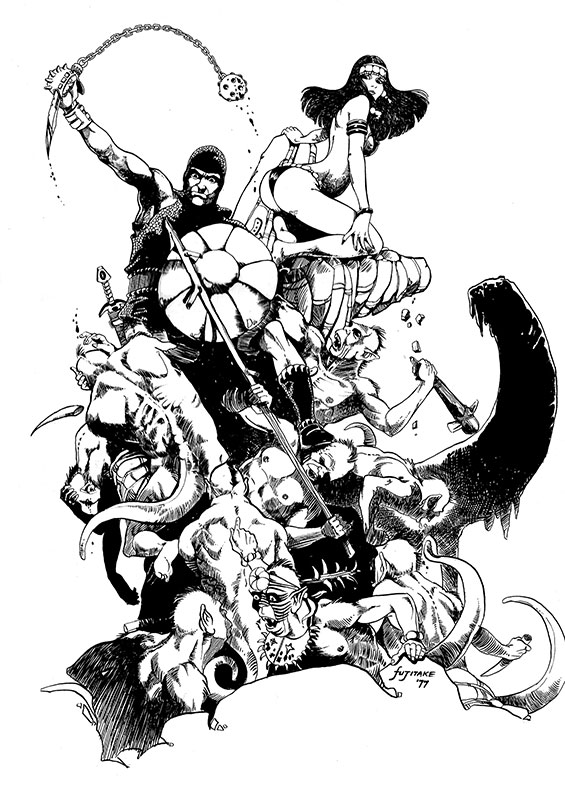

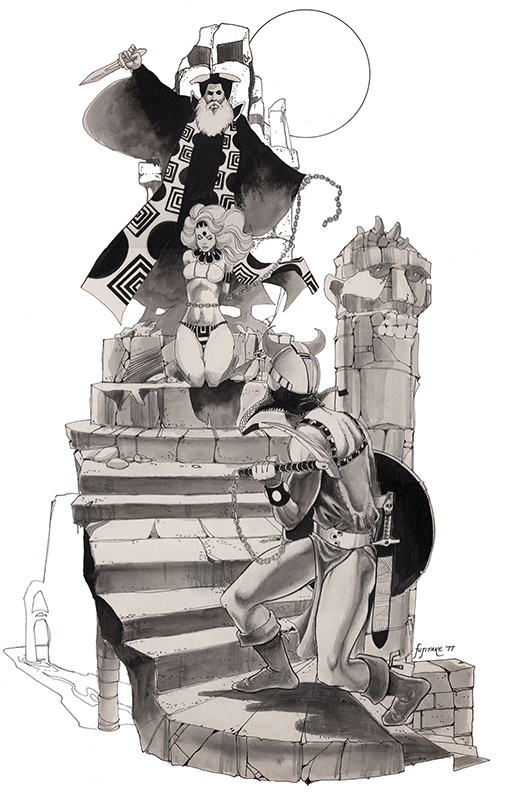
When asked about his early professional work, Dennis told me (via email) that…
This is where my memory, or the lack of it, is a problem. I like to brag my mind is like a steel sieve. To be honest I just don’t remember what my first pro job was. I do remember submitting a poorly drawn strip to Warren Publications and it being rejected. My skills at the time were lacking. If by ‘continuity’ you mean an series of linked stories then it would most likely be Dalgoda with Fantagraphics. I had been doing editorial art for Gary Groth and I did have an idea for a sub-space science-fi story that I mentioned to him. He paired me up with Jan Strnad who rewrote the entire plot with Dal as the main character.
I don’t recall Marvel or DC ever trying to get in touch with me despite my daily prayers that I be picked to replace Steve Ditko on Spider-man.
Though Dennis has not been in the comic scene for awhile, he has not stopped working. Below, to end the interview, he gives us a bit of an update. I highly recommend checkout out the link to his Mizfit story, it is incredibly fun and obviously really well done.
I like to think I faded into oblivion.
I worked at a couple of ad agencies in Honolulu to make a living as an illustrator. I later went freelance and did things like tee shirt designs, greeting cards and editorial art. I’ve also done a couple of local kids books, a couple of humor books on uses for a dead Gecko and a local comic book called Lil’ Keiki (keiki=kid in Hawaiian). I think there was maybe two issues of it but again my incredible memory fails me.
Nowadays, I still do some editorial art and cartoons for a couple of publications in Honolulu. There was a comic book that I began in the late 80’s or 90’s called Mizfit. I failed to find a publisher for it and it lay around collecting dust. Then, I discovered Tapastic, an online self-publishing site. This meant that all that work would not end up as termite food. I posted what I had already done and slowly began to add new pages to the series. I’m working to finish up the final pages of the 5th and last book right now. You can find it here.
I am so indebted to Dennis for taking the time to answer my questions, I am sure it made this installment of Ink Stains exponentially more interesting!
OK, to finish up the rest of this issue of RBCC, Van Hise shares some EC info in The EC Artist Collector, followed by Point/Counterpoint (Doug Haines and John Baglem), and the remaining pages are filled with ads (and I love seeing ads for a lot of the other zines of the era).
Be sure to get the pdf in the Ink Stains section of my site at kenmeyerjr.com, as there is much more to see and read! Again, thanks to the awesome Mr. Fujitake for indulging me! Please tune in next month for another adventure into the past!
Ken Meyer Jr.
kenmeyerjr@yahoo.com

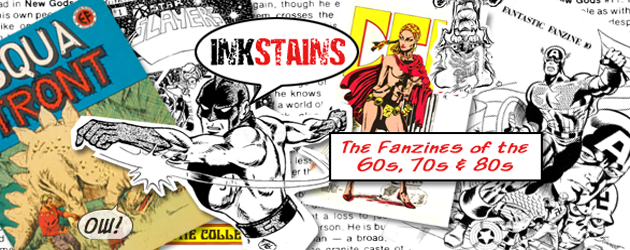
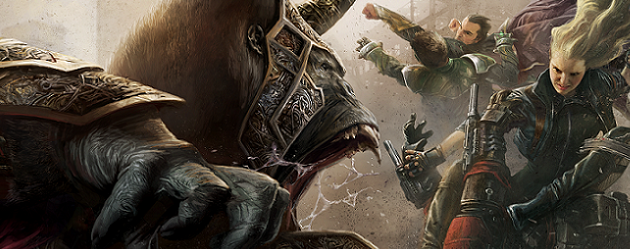
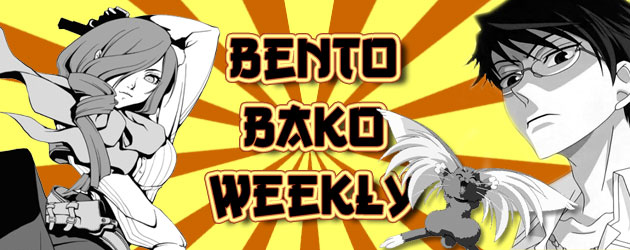
Great interview with Dennis! He is one of my favorites. I remember having a drawing published in a Comics Journal with a cover by Dennis. At least he got his art back from Alan Light, even if it was folded. One of my TBG covers never was returned to me. Ah, the old fandom days!
Thanks for reading, Bob!
Pingback: Ink Stains 127: Dennis Fujitake Narratives – ComicAttack.net